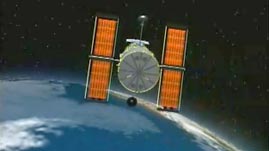Teachers' Domain - Digital Media for the Classroom and Professional Development
User: Preview

Source: Space Telescope Science Institute
Since its launch is 1990, the Hubble Space Telescope has provided scientists with a vast amount of quality data and has contributed to a number of important discoveries. One of the best-known images — the Hubble Deep Field — shows some of the earliest and faintest galaxies ever seen. In this video segment adapted from the Space Telescope Science Institute, learn how the Hubble Space Telescope created this amazing picture of the early universe.
From its low orbit just 600 km (373 mi) above Earth's surface, the Hubble Space Telescope is able to observe the universe with incredible clarity. Free from the atmosphere's turbulent air that blurs incoming light and absorbs infrared and ultraviolet wavelengths, Hubble has taken over 400,000 observations and provided data for thousands of scientific papers.
Since its launch in 1990, Hubble — the only space telescope to gather data in visible, infrared, and ultraviolet wavelengths — has offered a unique and detailed view of the universe. One of the most striking images produced by the telescope was the Hubble Deep Field (HDF). At the time of its release in 1996, HDF was the deepest optical view of the universe, showing the farthest and youngest galaxies ever to be seen. The image was taken of a tiny portion of sky and displays over 1,500 galaxies with a wide range of shapes and sizes.
The HDF has helped provide information about how galaxies form and the basic structure and evolution of the universe. For example, it has allowed astronomers to determine more accurately the Hubble constant — the rate at which the universe is expanding — which led to the surprising discovery that the rate is actually accelerating. It has provided the first images of new stars and solar systems being born, as well as the first convincing evidence for supermassive black holes. The Hubble Space Telescope has also been used to study planets and comet impacts.
Since the discovery of the HDF, service missions to Hubble have equipped the telescope with new and improved instruments that could see even deeper than before. In 2004, a new deep image was released — the Hubble Ultra Deep Field (HUDF). Like the HDF, this image shows a collection of very faint, young galaxies — approximately 10,000 galaxies with a tremendous range of sizes, shapes, and colors. This spectacular image shows what one section of the universe looked like just a few hundred million years after the Big Bang. These very young galaxies look quite different from the galaxies of today and are evidence of a much more chaotic time. The image offers insight into the beginning of the universe and the birth and evolution of galaxies.
 Loading Standards
Loading Standards Teachers' Domain is proud to be a Pathways portal to the National Science Digital Library.
Teachers' Domain is proud to be a Pathways portal to the National Science Digital Library.
